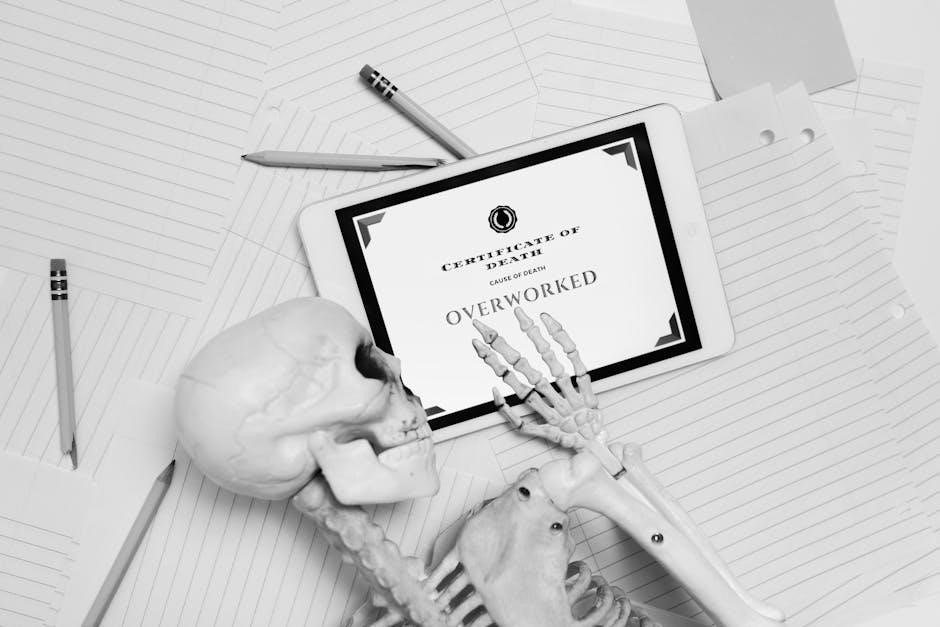Byron Katie’s Work offers a transformative method for self-inquiry, available through downloadable PDF guides; These resources provide tools like worksheets and the four questions to challenge stressful beliefs, fostering mental clarity and emotional peace. The PDFs are accessible online, making it easy to begin the practice of The Work anytime, anywhere.
1.1 Overview of The Work
The Work, developed by Byron Katie, is a transformative method of self-inquiry designed to identify and challenge stressful beliefs. It involves writing down thoughts about someone or something causing unrest, then questioning these beliefs using four specific questions and applying a “turnaround” to shift perspective. The process is supported by downloadable PDF worksheets and guides, which provide structured steps for reflection. This practice aims to reduce suffering by examining the validity of thoughts and fostering a deeper understanding of oneself. The simplicity and effectiveness of The Work make it accessible to anyone seeking emotional clarity and inner peace, guided by the tools available online.
1.2 Importance of Self-Inquiry
Self-inquiry, as taught by Byron Katie, is a transformative process that empowers individuals to examine and challenge stressful thoughts and beliefs. By questioning these thoughts, one can uncover their validity and release the emotional burdens they carry. The Work emphasizes that suffering arises from believing our thoughts without scrutiny. Through self-inquiry, individuals gain clarity, reduce emotional reactivity, and cultivate a deeper understanding of themselves and their experiences. The availability of PDF guides and worksheets simplifies this process, offering a structured approach to introspection. Regular practice of self-inquiry fosters mental freedom, emotional resilience, and a more peaceful relationship with life’s challenges.
This practice is foundational to achieving lasting inner peace and personal growth.
1.3 Benefits of The Work
The Work offers profound benefits, including the reduction of stress, anxiety, and depression by challenging and reversing limiting beliefs. It fosters improved relationships by clarifying misunderstandings and promoting empathy. Practitioners often experience increased self-awareness, leading to better decision-making and personal growth. The Work also enhances emotional resilience, helping individuals navigate life’s challenges with greater ease. By applying its principles, one can achieve a deeper sense of peace, freedom from emotional suffering, and a more authentic connection to their true self. These benefits create a lasting positive impact on both mental and emotional well-being, empowering individuals to live more fulfilling lives.
Regular practice amplifies these transformative effects.

Core Principles of The Work
The Work revolves around self-inquiry, the Four Questions, and the Turnaround, helping individuals question beliefs and transform suffering into awareness and peace through mindful reflection.
2.1 The Four Questions
The Four Questions are the foundation of Byron Katie’s Work, guiding individuals to question their beliefs and thoughts. They are: Is it true?, Can you absolutely know it’s true?, How do you react when you believe that thought?, and Who would you be without that thought? These questions encourage self-reflection, helping to identify and challenge stressful or limiting beliefs. By applying them, individuals can uncover the truth behind their thoughts and experience mental clarity. The questions are simple yet powerful tools for transforming suffering into understanding and peace, making them essential for practicing The Work effectively.
2.2 The Turnaround
The Turnaround is a powerful concept in Byron Katie’s Work, where individuals reverse their stressful thoughts to their opposites. For example, if the thought is “He doesn’t care about me,” the Turnaround could be “He does care about me” or “I don’t care about him.” This practice helps uncover new perspectives, reducing suffering by challenging rigid beliefs. The Turnaround isn’t about forcing a new belief but rather exploring the possibility of the opposite thought. It encourages balance and openness, allowing individuals to see situations differently and find peace in their understanding. Regular practice deepens self-awareness and fosters emotional freedom.
2.3 The Role of Beliefs in Suffering
In Byron Katie’s Work, beliefs are identified as the root of suffering. When individuals hold onto thoughts without questioning them, they create emotional pain. The Work teaches that it is not events themselves that cause suffering but the beliefs and interpretations attached to those events. By examining and challenging these beliefs through the Four Questions, individuals can uncover the truth behind their thoughts. Unquestioned beliefs act as filters, distorting reality and perpetuating cycles of stress and unhappiness. The Work encourages people to investigate their beliefs, fostering freedom from mental and emotional distress. This process reveals how beliefs shape suffering and offers a path to liberation from them.

How to Do The Work
The Work involves identifying stressful thoughts, writing them down, and applying the Four Questions to challenge beliefs. Regular practice fosters clarity and inner peace.
3.1 Identifying Stressful Beliefs
Identifying stressful beliefs is the first step in The Work. These beliefs are thoughts that cause emotional discomfort, such as anxiety or anger. They often appear as judgments or assumptions about oneself, others, or situations. To recognize them, pay attention to recurring, distressing thoughts or those that trigger strong reactions. For example, beliefs like “I need control” or “They should understand me” can create suffering. Reflect on situations that disturb you and notice the underlying thoughts. Writing them down helps clarify and confront them. This process allows you to question their validity and move toward liberation. Start with what troubles you most, and explore deeply.
3.2 Writing Down Your Thoughts
Writing down your thoughts is a crucial step in The Work, as it transforms abstract ideas into tangible statements. Use a worksheet to capture stressful beliefs clearly and concisely. Be specific and avoid generalizations; for example, instead of writing “I’m angry,” note “I’m angry when they don’t listen to me.” This clarity helps you examine beliefs objectively. Write without editing or censoring yourself, allowing raw emotions to flow. This process ensures your thoughts are grounded and ready for inquiry. Once written, these statements become the foundation for applying the Four Questions, making it easier to investigate their truth. This step is essential for effective self-inquiry.
3.3 Applying the Four Questions
Applying the Four Questions is the heart of Byron Katie’s Work, designed to dismantle stressful beliefs. Start with the first question: “Is it true?” Examine whether the thought is objectively true. Next, ask, “Can you absolutely know it’s true?” This encourages deeper reflection. The third question, “How do you react when you believe that thought?” reveals the emotional and behavioral impact. Finally, “Who would you be without that thought?” invites you to envision life without the belief. This process helps identify thoughts that cause suffering and opens the door to transformation. Regular practice deepens self-awareness and fosters clarity.
3.4 Practicing the Turnaround
Practicing the Turnaround is a powerful step in Byron Katie’s Work, helping to challenge and transform stressful beliefs. After applying the Four Questions, the Turnaround involves reversing the original thought to explore its opposite. For example, if you think, “He doesn’t care about me,” the Turnaround might be, “He does care about me,” or even, “I don’t care about him.” This practice encourages you to consider new perspectives and question assumptions. There are also “other turnarounds,” where you apply the thought to yourself or others. Regular practice of the Turnaround can reduce conflict, increase empathy, and deepen understanding of your beliefs.

Practical Applications of The Work
The Work offers practical tools for daily life, helping individuals address stress, improve relationships, and enhance self-awareness through simple, effective exercises and mindset shifts.
4.1 Using Worksheets for The Work
Worksheets are essential tools for applying Byron Katie’s methods effectively. They provide a structured format for identifying and questioning stressful beliefs. Users can download PDF worksheets from official sources, which guide them through the four questions and turnarounds. These documents often include space for writing thoughts, beliefs, and insights, making the process organized and reflective. Worksheets are particularly helpful for beginners, as they offer a clear roadmap for self-inquiry. Regular use of these resources can enhance clarity, reduce emotional reactivity, and deepen understanding of The Work. They are accessible, practical, and designed to support consistent practice in daily life.
4.2 Doing The Work with a Partner
Engaging in The Work with a partner can deepen your practice and provide new insights. It allows for dynamic interaction, where one person acts as the facilitator while the other inquires into their beliefs. Active listening and honest sharing are key to this collaborative process. Partners can help identify patterns or thoughts that might go unnoticed when working alone. This method fosters mutual understanding, empathy, and accountability. Regular partner work can accelerate personal growth and strengthen relationships. It’s important to approach the process with openness and a commitment to nonjudgmental exploration. This shared approach often leads to profound breakthroughs and deeper self-awareness.
4.3 Incorporating The Work into Daily Life
Incorporating The Work into daily life involves making it a consistent practice, even in small moments. Start by using worksheets to identify and question stressful thoughts throughout the day. Set reminders to pause and reflect on your beliefs, especially during stressful situations. Practice self-inquiry while commuting, during breaks, or before bed. This habit helps reduce reactivity and fosters greater self-awareness. For example, question a thought like, “They shouldn’t have done that,” and explore its validity. Regular practice leads to a calmer, more mindful approach to life. Consistency is key to integrating The Work into your routine and experiencing its transformative benefits.

The Role of PDF Resources
PDF resources provide structured guidance for practicing The Work, offering worksheets, step-by-step instructions, and insights to enhance understanding and application of Byron Katie’s methods effectively.
5.1 Downloading Worksheets
Downloading worksheets is a straightforward process that provides immediate access to structured tools for practicing The Work. Official websites and resources offer free PDF downloads, ensuring users can begin their inquiry without delay. These worksheets are designed to guide individuals through the four questions and turnaround process, offering clarity and focus. They often include space for writing thoughts, beliefs, and insights, making it easier to track progress. Having a physical copy allows for greater engagement and reflection. Regular use of these worksheets can deepen understanding and consistency in practice, helping users stay committed to their journey of self-discovery and emotional freedom.
5.2 Guides for Self-Coaching
Guides for self-coaching are essential tools for anyone exploring The Work independently. These resources provide step-by-step instructions, practical exercises, and insightful prompts to help users apply the four questions and turnarounds effectively. Designed to foster self-awareness, they often include checklists, reflection spaces, and actionable tips. Many guides are structured to accommodate daily practice, making it easier to integrate The Work into a busy routine. By following these guides, individuals can deepen their understanding of Byron Katie’s principles and develop a consistent practice. They empower users to take ownership of their growth, offering a clear path toward greater clarity, peace, and personal transformation.
5.3 Accessing Free Materials
Accessing free materials for The Work is straightforward, with many resources available online. Byron Katie’s official website offers free downloadable worksheets and guides, perfect for those new to the practice. These materials include the four questions and turnarounds, providing a clear framework for self-inquiry. They are designed to help users identify and challenge stressful beliefs, making them invaluable for daily practice. The free resources are a great starting point, allowing anyone to explore The Work without financial barriers. They offer practical tools and insights, making the process accessible and engaging for everyone interested in personal growth and mental clarity.

Emotional and Mental Benefits
The Work offers numerous emotional and mental benefits. It reduces stress, alleviates anxiety, improves relationships, and enhances self-awareness, promoting inner peace and emotional balance.
- Reduces stress and anxiety by challenging negative thoughts.
- Improves relationships through better communication and understanding.
- Enhances self-awareness, fostering personal growth and clarity.
6.1 Reducing Stress and Anxiety
Engaging in The Work can significantly reduce stress and anxiety by addressing the root causes of emotional distress. By examining stressful beliefs through the four questions, individuals can identify and challenge negative thought patterns that fuel anxiety. This process fosters a deeper understanding of how thoughts create emotional reactions, allowing for a shift in perspective. Regular practice of The Work helps cultivate mindfulness and emotional resilience, leading to a calmer and more peaceful state of mind. Over time, this practice can diminish the intensity of stressful emotions, promoting overall well-being and mental clarity. Worksheets from the PDF guide provide structured support for this journey.
6.2 Improving Relationships
The Work of Byron Katie offers powerful tools for improving relationships by transforming how we perceive others. By questioning stressful beliefs about partners, friends, or family, we often discover that our suffering stems from our own projections. The four questions help us identify and challenge assumptions, fostering empathy and understanding. Practicing the turnaround encourages taking responsibility for our actions and emotions, leading to more authentic connections. Worksheets from the PDF guide provide a structured way to explore and shift limiting beliefs, ultimately enhancing communication and harmony in relationships. This process promotes mutual respect and collaboration, creating a foundation for healthier interactions and deeper intimacy.
6.3 Enhancing Self-Awareness
The Work of Byron Katie is a transformative process that deeply enhances self-awareness by inviting individuals to explore their thoughts and beliefs. Through the four questions and turnarounds, participants gain clarity about their mental patterns and how these shape their experiences. By identifying and questioning stressful beliefs, people often discover that their perceptions are not absolute truths but optional interpretations. This realization fosters a heightened sense of self-awareness, allowing individuals to observe their thoughts without being controlled by them. The PDF guide provides practical exercises to apply this inquiry, helping users uncover their authentic selves and live more mindfully and authentically.

The Work in Education
The Work of Byron Katie can be integrated into educational settings to foster self-awareness, emotional intelligence, and critical thinking among students and educators, enhancing learning environments and relationships.
7.1 Teaching The Work in Schools
Introducing The Work in schools empowers students and educators to cultivate self-awareness and emotional resilience. By teaching the four questions and the turnaround, students learn to question stressful thoughts and shift perspectives. Educators can integrate these exercises into daily routines, fostering a calmer and more focused classroom environment. Worksheets from the “how to do the work PDF” provide structured guidance, helping students identify and challenge limiting beliefs. This approach not only enhances emotional well-being but also improves academic performance and interpersonal relationships, creating a more supportive and inclusive educational setting for everyone involved.
7.2 Using The Work for Academic Success
The Work offers powerful tools to enhance academic success by addressing mental barriers that hinder learning. Students can apply the four questions to challenging beliefs like “I’m not smart enough” or “I’ll never understand this,” transforming self-doubt into confidence. Worksheets from the “how to do the work PDF” guide learners in identifying and questioning limiting thoughts, fostering a clearer, more focused mind. By practicing self-inquiry, students develop resilience, improved problem-solving skills, and a growth mindset. This approach not only boosts academic performance but also cultivates lifelong skills for managing stress and achieving personal goals, empowering learners to thrive in all areas of life.
7.3 The Work and Language Learning
The Work can be a transformative tool for language learners, helping to dissolve barriers that hinder fluency and confidence. Byron Katie’s four questions encourage learners to examine beliefs like “I’m not good at languages” or “I’ll never speak fluently,” revealing how these thoughts create unnecessary resistance. Worksheets from the “how to do the work PDF” guide learners in identifying and questioning such limiting beliefs, fostering a more open and curious mindset. By applying The Work, language learners can reduce self-criticism, enhance motivation, and embrace the process of learning with greater ease and enjoyment, leading to more effective and joyful language acquisition.

Advanced Techniques in The Work
Advanced techniques in The Work involve deeper meditative practices, refining self-inquiry, and mastering the Turnaround to confront complex beliefs and emotions effectively.
8.1 Meditative Practices
Meditative practices deepen the effectiveness of The Work by cultivating mindfulness and presence. These techniques, often outlined in guides like the “How to Do The Work” PDF, help individuals focus on their beliefs without attachment. Through meditation, practitioners can observe thoughts neutrally, allowing for clearer self-inquiry.Guided meditations from the PDF often include reflection on the four questions, fostering a calm and introspective state. Regular practice enhances mental clarity, emotional resilience, and the ability to question stressful beliefs more effectively. By integrating meditation, one can experience profound shifts in perception, aligning with Katie’s philosophy of inner peace through self-investigation.
8.2 Deepening Your Inquiry
Deepening your inquiry involves moving beyond surface-level questions to explore beliefs more profoundly. The “How to Do The Work” PDF often emphasizes the importance of patience and persistence in this process. Techniques include sitting with each question longer, exploring different perspectives, and challenging assumptions. Journaling can help uncover hidden beliefs, while guided exercises encourage a deeper examination of thoughts. By repeatedly asking, “Is this true?” and seeking examples, individuals gain clarity and insight. This step is crucial for fully understanding the root of suffering and experiencing lasting freedom from limiting beliefs. Regular practice strengthens the ability to question deeply held assumptions.
8.3 Overcoming Challenges
Overcoming challenges in The Work involves addressing resistance and staying committed to self-inquiry. The “How to Do The Work” PDF suggests that challenges often arise from deeply ingrained beliefs or emotional attachment. To overcome these, practitioners can use mindfulness to observe thoughts without judgment and remind themselves of the purpose of The Work. Seeking support from experienced facilitators or joining groups can also help navigate difficult inquiries. Persistence is key, as challenges often signal areas where deeper understanding is needed. By embracing obstacles as opportunities for growth, individuals can move past barriers and deepen their practice, leading to greater freedom and clarity in their lives. Regular practice and self-compassion are essential for sustaining progress through challenging times.

Real-Life Examples and Case Studies
The “How to Do The Work” PDF shares real-life examples of individuals transforming their lives through The Work. These case studies highlight practical applications, improved relationships, and reduced stress, inspiring others to embrace the process and experience similar positive changes.
9.1 Success Stories
The “How to Do The Work” PDF features inspiring success stories of individuals who transformed their lives using Byron Katie’s methods. One woman overcame debilitating anxiety by questioning her thoughts, while a man improved his marriage by applying the Turnaround. These stories demonstrate how The Work fosters emotional freedom, resilience, and profound personal growth. Readers are motivated to embrace the process, seeing real-world evidence of its power. The PDF highlights diverse experiences, proving The Work’s versatility in addressing various challenges. These success stories serve as powerful encouragement for anyone seeking to apply The Work in their own lives.

9.2 Common Scenarios
The “How to Do The Work” PDF highlights common scenarios where individuals apply Byron Katie’s methods. These include addressing relationship conflicts, managing work stress, and overcoming self-doubt. For example, one scenario involves a person struggling with anger toward a partner, while another deals with fear of failure at work. The PDF provides practical guidance on how to question thoughts and apply the Turnaround in these situations. By exploring these relatable challenges, readers gain clarity on how to approach their own struggles. The examples demonstrate the universality of The Work, showing how it can be applied to everyday life’s difficulties for lasting change.
9.3 Lessons Learned
The “How to Do The Work” PDF emphasizes key lessons from practicing Byron Katie’s methods. A primary lesson is the importance of consistent practice to deepen self-awareness. Many learners discover that their suffering stems from believing their thoughts, not the circumstances themselves. The PDF also highlights the value of patience and self-compassion during the inquiry process. Participants often learn to approach challenging situations with curiosity rather than resistance. Over time, they develop the ability to question beliefs that once seemed absolute. These lessons underscore the transformative potential of The Work, enabling individuals to embrace life’s difficulties with greater clarity and resilience.
Byron Katie’s Work provides a transformative guide to inner peace, using self-inquiry and practical tools to reduce stress, improve relationships, and foster meaningful personal and professional connections.
10.1 Recap of Key Points
The Work of Byron Katie offers a powerful method for self-inquiry, helping individuals question stressful beliefs and transform their mindset. Central to this practice are the Four Questions and the Turnaround, tools designed to challenge assumptions and foster clarity. By identifying and examining limiting beliefs, participants can reduce suffering and cultivate inner peace. The process encourages self-awareness, improved relationships, and a deeper understanding of personal thoughts and emotions. Regular practice, guided by downloadable PDF worksheets, supports consistent growth and mindfulness in daily life, empowering individuals to embrace change and live more authentically.
10.2 Encouragement to Practice
Embracing The Work as a daily practice can lead to profound mental clarity and emotional well-being. Consistency is key, as even small moments of inquiry can foster lasting change. Remember, The Work is accessible anywhere, requiring only your willingness to question thoughts. Don’t hesitate to start with one stressful belief and grow from there. Celebrate small victories, as they build momentum. Share your journey with others to deepen understanding and stay motivated. With patience and dedication, The Work can become a transformative tool, guiding you toward a more peaceful and authentic life. Begin now and witness the power of self-inquiry.
10.3 Next Steps
After exploring The Work, take actionable steps to integrate it into your life. Start by downloading the How to Do The Work PDF to access structured worksheets and guides. Begin with one belief or stressor, applying the Four Questions and Turnaround. Share your insights with a partner or join a group for deeper understanding. Consistency is key—commit to daily practice, even for 10–15 minutes. Track your progress and reflect on how your perceptions shift. Remember, The Work is a journey, not a destination. Be patient, and celebrate small breakthroughs. With dedication, you’ll unlock its full potential and live a more authentic, peaceful life.